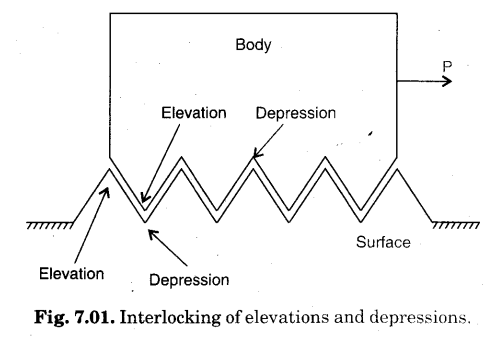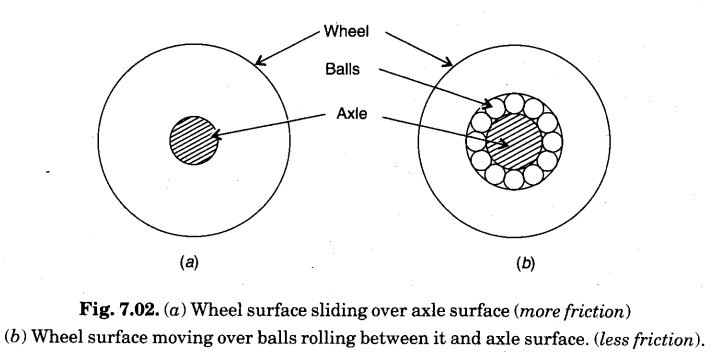Friction
Friction
(a) Definition. Whenever a body moves or tends to move over the surface of another body, a force comes into play which acts parallel to the surface of contact and opposes the relative motion. This opposing force is called friction.
(b) Type. It has following types :
(i) Static friction. It is the friction between two surfaces of bodies at rest due to impending motion.
(ii) Dynamic (or kinetic) friction. It is the friction between two surfaces of bodies in motion. It is slightly less than the static friction.
Dynamic friction has two types :
(i) Sliding friction. It is the friction in sliding motion.
(ii) Rolling friction. It is the friction in rolling motion.
Rolling friction is less than the sliding friction.
(c) Nature of static friction. It has following nature :
(i) It is a self-acting force. It acts by itself.
(ii) It is a self-adjusting force. It adjusts its magnitude and direction to keep itself always equal and opposite to the horizontal force applied to move the body at rest.
(iii) It has a limiting value (maximum value) called limiting friction. The limiting friction is equal to the least force required to move the body from rest.
Origin of friction
The following two factors are responsible for the friction :
1. Roughness of surfaces is the cause of friction. The roughness or irregularities of surfaces provide the interlocking between the two surfaces when the surfaces are in relative motion. Interlocking of the elevations and the depressions of the lower surface and bottom surface of the bodies are shown in (Fig. 7.01). When the body is pulled, elevations collide and friction provide.
2. Force of attraction between molecules in the lower surface and bottom surface of the body. It is called adhesive force.

Friction is necessary
Friction plays an important part in daily life. In its absence, many acts may not be able to be performed. They are given below :
- Without friction, a motion cannot be started. We cannot walk on a friction less surface.
- Without friction, a motion cannot be stopped. Brakes will not work if there is no friction.
- Without friction, a motion cannot be transferred. The belt will not be able to rotate a machine wheel by motor wheel if there is no friction between belt and wheels.
- Without friction, knots will not stay. Packing, tying, bandaging will be difficult.
- Without friction, grinding will not take place. Wheat and spices will not be grinded.
- Without friction, nails will not stay in position. It will be difficult to assemble a furniture item.
- Without friction, match stick will not ignite.
- Without friction, writing on a surface will not be possible.
- Without friction, holding the things will not possible.
- Without friction, eating is not possible etc.
Friction is evil
Though friction is useful in many fields, it is harmful (evil) in the followings.
1. Due to friction between different parts of a machine, wear and tear of parts take place and excessive heat is produced. This reduces the life of the machine.
2. Unnecessary, expense of energy to overcome the friction. Hence, output is always less than input.
Reduction of friction
In cases where friction is taken as an evil, it is desired to reduce it. The friction can be reduced by following methods :
- Smoothening the surface by rubbing and polishing. Rubbing reduces height of elevations. Polishing fills the reduced depth of depressions. In the absence of elevations and depressions, interlocking reduces. Friction becomes reduced.
But too much smoothness of surfaces in contact increases friction. It is so because the molecules of the two surfaces come in close contact. Attraction between the molecules increases, which increases friction. - Lubricating the surfaces in contact by a proper lubricant. Lubricant between two surfaces keeps them separate and prevents interlocking. This reduces friction.
Selection of lubricant must be proper, Grease must be used for heavy bodies, heavy oil must be used for bodies of moderate weight and light oil must be used for light bodies. - Lining the surfaces or surface with soft material. Hard material surfaces have more friction due to strong forces of attraction between their molecules. (They are hard, be-cause of this strong force). To reduce friction between them, without effecting their strength, they are lined (coated) with soft material. Contact between soft material surfaces experiences less friction.
Steel wheels of trains are lined with lead to reduce friction between them and steel rail track. - Converting sliding friction into rolling friction. When wheel is mounted direct on axle, surface of wheel hole slides over axle surface as the wheel rolls [Fig. 7.02 (a)]. There is more friction. The motion becomes slow.

But when balls (ball bearings) are introduced between axle surface and hole surface of wheel, situation becomes different [Fig. 7.02 (6)]. Now when the wheel rolls, balls roll and surface of hole moves over rolling balls. Friction is considerably reduced.
It is for this reason that all movable heavy bodies are provided with wheels at bottom (examples are hospital bed, stretcher, large-sized suitcases etc.). - By streamlining. Friction due to air is reduced by streamlining the shape of the body moving through air. For example jets, aeroplanes, fast moving cars etc.
Incrasing friction
In cases where friction is necessary, it is desired to increase it. The friction can be in-creased by following methods (which are reverse of reduction methods).
- Roughening the surface by chiseling it.
- Sanding the surface.
- Lining with hard material.
- Converting rolling friction into sliding friction.
When brakes are applied on a moving vehicle, rolling of wheels stop. Then wheels slide on the road. Due to friction, vehicle stops.
Laws of limiting friction
There are four laws of limiting friction. They are stated below :
- First Law (law for direction). Limiting friction acts tangential to the surfaces in contact, in backward direction (i.e., opposite to direction of motion).
- Second Law (law for magnitude). Limiting friction is directly proportional to the normal reaction acting on the body.

- Third Law (law of dependence). Limiting friction depends upon the nature (rough or polished) and the material (hard or soft) of the surfaces in contact.
- Fourth Law (law for independence). Limiting friction is independent of the area and the shape of the surfaces in contact.
Coefficient of friction
Definition. The limiting friction is directly proportional to the normal reaction. If F be the limiting friction and R be the normal reaction, then
μ =F/R
F=μ R
Here μ is called coefficient of friction, μ does not has unit and dimensions because it is the ratio, of two like physical quantities.
Angle of friction
Definition. It is the angle that the resultant of limiting friction an<J normal reaction makes with the normal reaction. It is shown by θ in diagram.

Angle of sliding or angle of repose
Definition. It is the angle of inclination of a rough surface with horizontal, such that a body kept over it, just starts to sliding down.
Relation. Figure 7.04 shows a body of mass m and weight mg kept on a surface inclined at an angle θ with horizontal.

Forces acting on the body are also shown in the diagram (Fig. 7.04).
When body just starts to sliding down,
For equilibrium along inclined plane, mg sin θ = F (limiting friction)
For equilibrium along normal to inclined plane, mg,cos θ = R (normal reaction)

or tan θ = μ
Hence, tangent of angle of repose is equals to the coefficient of static friction.
(c) Application. Using an inclined plane with variable angle of inclination, coefficient of friction can be determined.
Physics Lab ManualNCERT Solutions Class 11 Physics Sample Papers
<!–
–>